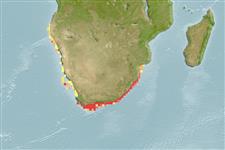Elasmobranquios (tiburones y rayas) (sharks and rays) >
Myliobatiformes (Stingrays) >
Dasyatidae (Stingrays) > Dasyatinae
Etymology: Dasyatis: Greek, dasys = rough, dense (Ref. 45335).
Environment: milieu / climate zone / depth range / distribution range
Ecología
marino demersal; rango de profundidad 1 - 110 m (Ref. 114953). Tropical; 15°S - 36°S, 10°E - 34°E (Ref. 114953)
Southeast Atlantic: central Angola to at least St. Lucia, Natal, South Africa, possibly extending to Mozambique. Reported from the Comoros, Reunion and Madagascar (Ref. 33390).
Tamaño / Peso / Age
Maturity: Lm ? range ? - ? cm
Max length : 75.0 cm WD macho / no sexado; (Ref. 36731)
Found in shallow bays, sheltered sandy beaches in summertime, moves to deeper waters during winter. Feeds on bony fishes and crustaceans such as crabs, shrimps and mantis shrimps (Ref. 36731); including sea lice and marine worms (Ref. 114953). Ovoviviparous (Ref. 50449). Litters of 1-5 pups (Ref. 114953). Often caught by shore anglers (Ref. 36731). It is parasitised by the monogenean Dendromonocotyle citrosa on the dorsal skin surface (Ref. 124058).
Life cycle and mating behavior
Madurez | Reproducción | Puesta | Huevos | Fecundidad | Larva
Exhibit ovoviparity (aplacental viviparity), with embryos feeding initially on yolk, then receiving additional nourishment from the mother by indirect absorption of uterine fluid enriched with mucus, fat or protein through specialised structures (Ref. 50449). Distinct pairing with embrace (Ref. 205).
Cowley, P.D. and L.J.V. Compagno, 1993. A taxonomic re-evaluation of the blue stingray from southern Africa (Myliobatiformes: Dasyatidae). S. Afr. J. Mar. Sci. 13:135-149. (Ref. 33465)
IUCN Red List Status (Ref. 130435)
Warning: mysqli::__construct(): (HY000/1040): Too many connections in /var/www/html/includes/func_getlabel.php on line 46
Can't connect to MySQL database (fbapp). Errorcode: Too many connections
